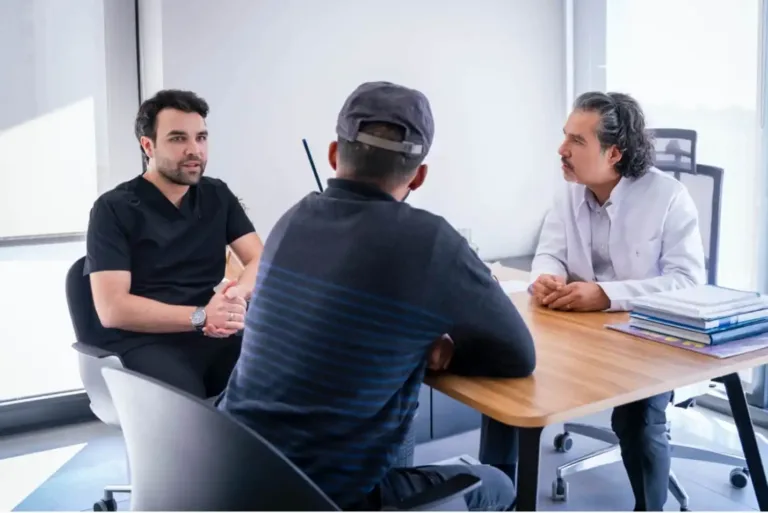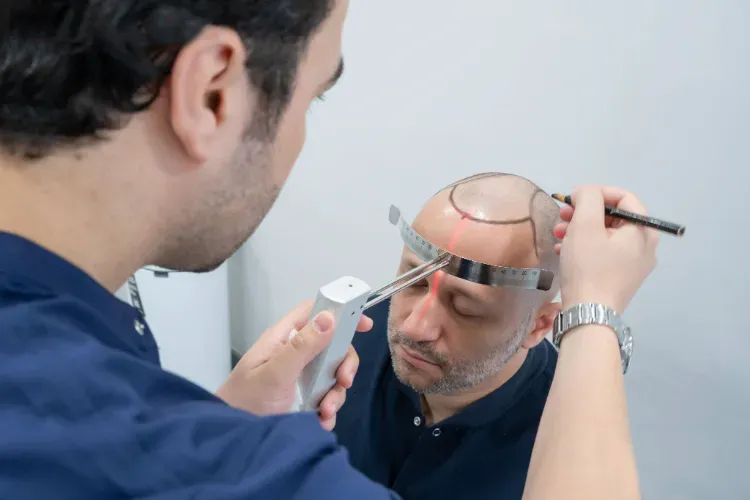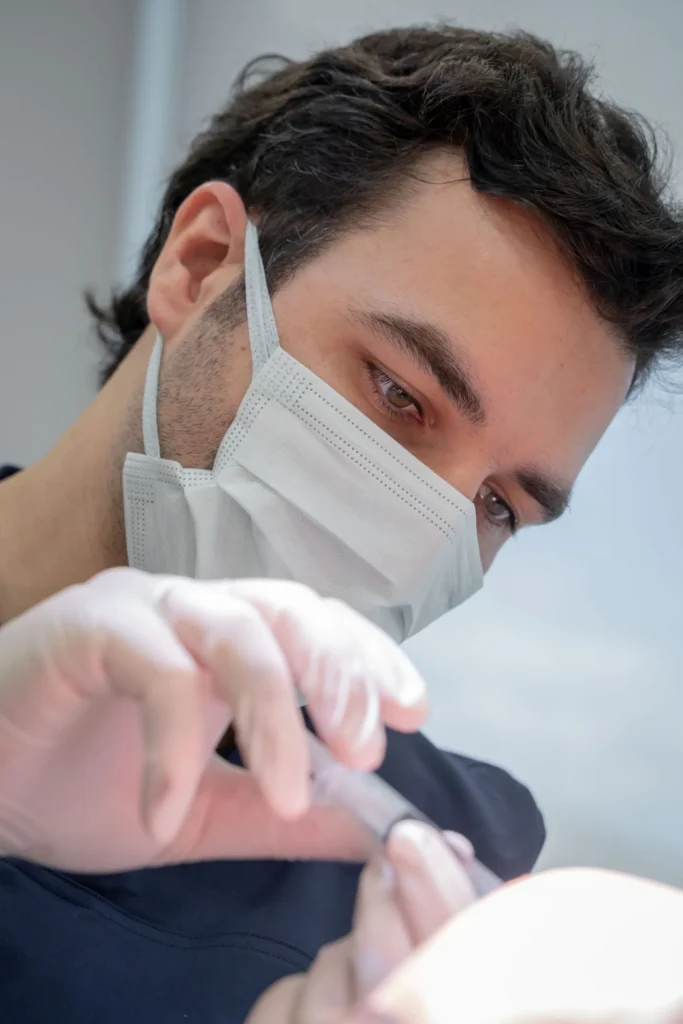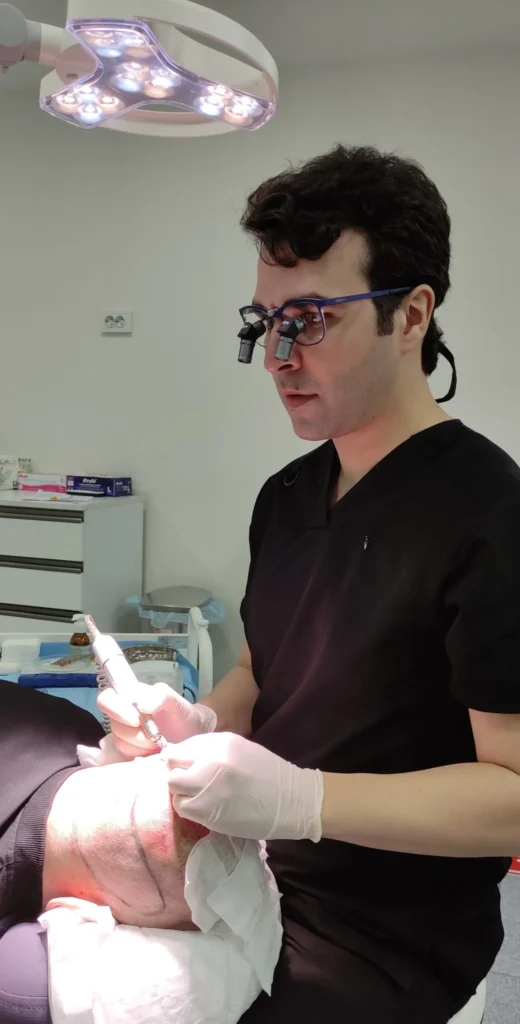FUE Hair Transplant- Follicular Unit Extraction
What is FUE Hair Transplant?
Follicular Unit Extraction (FUE Hair Transplant), now known as Follicular Unit Excision, is a method of hair transplantation. In this method, individual hair follicles are harvested from the safe donor area and implanted in the recipient area.
When the safe donor is not sufficient, grafts can also be extracted from alternative donor areas such as the beard, the chest, the arms, or the legs.
Over the past few years, the FUE method has become the gold standard of hair restoration. It is the preferred method of doctors worldwide, including our surgeons at Civas&Akpınar Hair Transplant Turkey, due to its precision, versatility, and ability to create more natural-looking results.
How Do FUE Hair Transplants Work?
FUE hair restoration works by excising hair follicles, also known as follicular units or FUs, one by one from the back and the sides of the head and implanting them in the bald spots or sparse areas suffering from hair loss.
A specialized tool called an extraction punch is used by surgeons to extract the FUs one by one. This ensures that minimal trauma or damage is done to the grafts and the surrounding tissue.
Each follicular unit is then individually implanted into micro-incisions made by the surgeon in the recipient area. While most patients undergo an initial shedding phase, the newly transplanted grafts will typically start growing around the 2nd or third month, with the final results becoming apparent a year after the procedure. Patience is KEY!!
What are the Steps of FUE Hair Transplant?
Follicular Unit Excision can be broken down into several steps, which will be explained in detail in the step-by-step guide below.
Step-by-Step Guide to FUE Transplantation
Step 1: Consultation

FUE hair transplant consultation with expert dermatologists
Before undergoing surgery, it is vital to consult with a hair transplant specialist, preferably a dermatologist, such as the ones at Civas&Akpınar, to determine whether you are a suitable candidate.
Following a dermatoscopic examination, our doctors will determine the cause of hair loss, the treatment plan, the technique to be used, and the number of grafts required for a successful outcome. They will work closely with you to understand your preferences and expectations and create a personalized treatment plan tailored to your specific needs.
Step 2: Hairline Design and Operation Planning

hair transplant surgeon performing the hairline design part of the procedure
During the hairline design stage of the process, your scalp will be prepared for the hair restoration procedure. By taking various factors such as facial anatomy, hair density, hair type, hair structure, available donor hair, etc., in mind, the doctor will design a natural-looking hairline that complements your facial features. They will also decide on the graft placement to mimic your natural hair pattern, angles, and distribution.
At Civas&Akpınar, we are truly dedicated to creating natural-looking and aesthetically pleasing hairlines. Over the years, our dermatologists have developed their own technique to ensure that each patient’s new hairline blends naturally with their existing hair and frames their facial features nicely. The remaining grafts will also be placed to ensure maximum coverage and the illusion of maximum density.
Step 3: Anesthesia

Hair transplant surgeon doing anesthesia before the procedure
The administration of anesthesia is a crucial part of the surgery. Since hair transplants are minimally invasive, it is done under local anesthesia. While the initial injections can be slightly painful, when done correctly, your scalp will be completely numb throughout the rest of the procedure.
This step of the process must be performed by a dermatologist doctor. This ensures that you will have a safe, pain-free, and stress-free experience throughout.
At Civas&Akpınar, our doctors have created their own anesthesia administration technique. By using a combination of nerve block and infiltration anesthesia, we can achieve an almost painless and long-lasting effect with only a minimal dosage of the local anesthetic solution.
Step 4: Incisions (Channel Opening)

hair doctor opening channels (incisions) in the recipient area
Once your scalp is prepped and fully numb, the specialist will start by making micro-incisions in the recipient area using specialized blades, sapphire blades, or DHI needles, depending on the areas to be treated, your hair structure, and your skin structure. This step is also known as channel opening.
These microchannels are strategically placed by doctors to give you maximum coverage and density. The size, direction, angles, and depth of the channels are all determined by the doctor to ensure that the grafts are placed in a way that mimics the natural growth pattern of your existing hair and contributes to a natural hair transplant result.
Step 5: Excisions (Extraction)
The next step of hair restoration surgery is the extraction phase. Extraction consists of selecting the best quality grafts and harvesting them one by one. The first part of the extraction process consists of selecting the right tools to excise the grafts intact.

Hair restoration doctor performing extractions
A specialized tool called a punch is used for excision. The extraction punches work by scoring the skin around the follicles and separating it from surrounding tissue to excise them. These punches come in different sizes, shapes, and sharpness.
From 0.7mm to 1.1mm, these punches are available in different diameters to adapt to the diameter of the follicular units. The right size of diameter allows the surgeon to extract the hairs intact and with low risks of transsection.
Each punch also varies in sharpness from blunt to sharp, and this allows the surgeon to precisely extract the grafts intact without causing unnecessary trauma to the surrounding follicular unit tissue.
The punches also differ in shapes, such as cylindrical, conical, trumpet, or serrated, which allows them to fit around the follicular unit perfectly and minimize tissue damage.
Once the appropriate punch is selected, the hair transplant surgeon will also determine the depth at which the punch penetrates the skin for the successful extraction of intact grafts.
Step 6: Sorting and Counting of FUs

Grafts being counted and sorted individually during FUE hair transplant procedure
While the hair follicles are harvested, nurse technicians will sort and count them one by one. Using magnification, they will separate them into groups of 1FUs, 2FUs, 3FUs, 4FUs, etc., and store them in a special organ-holding solution until it is time for implantation.
Graft Placement (Implantation)

Graft implantation into the recipient area using forceps
Once extraction, sorting, and counting of the grafts are completed, the phase of implantation can begin. Implantation consists of delicately inserting the grafts in the slits/incisions previously made by the hair transplant specialist.
This requires technical precision to ensure that only 1 FUs are added to the hairline to ensure that the hairline is smooth and looks natural. Double and triple FUs are strategically added behind the hairline to create more density.
At Civas&Akpınar, implantation is performed by skilled nurse technicians. Trained by our doctors and backed by years of practical experience, our team of nurse techs will expertly place the sorted grafts in the channels under the direct supervision of our doctors.
Step 8: Bandage Application
After implantation, the hair transplant process is almost over. At this stage, your scalp will be cleaned, followed by the application of a topical antibiotic lotion to support healing and eliminate the risks of infection.
Your head will then be bandaged to protect the donor. Please note that the recipient area will be left uncovered. This is done to minimize friction and reduce the risk of dislodging the newly implanted grafts.
Step 9: Post-Op Instructions
After the procedure, it’s time to focus on what comes next- recovery. It is important to follow the post-op instructions that your hair restoration clinic has carefully prepared to obtain optimal results. These cover aftercare for the donor and recipient areas, medication, activities that should be avoided during the healing period, etc.
The process doesn’t end with the procedure itself but extends long into the recovery period. By following the guidelines set up by the doctor, you contribute significantly to your hair transplant results, minimizing the risks of complications and speeding up the healing process.
FUE Hair Transplant Techniques
There are several subcategories of FUE hair transplant surgery, each with unique approaches and technologies
- Manual FUE Hair Transplant Technique
In the manual FUE procedure, a manual punch is used for extraction. This allows the surgeon better control and precision during the extraction process, but it can be very time-consuming and can cause fatigue, which can affect the quality of the grafts extracted.
- Motorized FUE Hair Transplant Technique
In the motorized FUE hair transplant technique, a motorized punch tool is used for graft extraction. A micromotor is attached to the punch device. The settings of the micromotor punch, such as speed, rotation, etc., can be adjusted to the needs of each patient. This speeds up the extraction process, reducing overall surgery time. It also allows the extraction of a larger number of grafts. However, if not handled properly or in the hands of an inexperienced technician, this can increase the transsection rate and cause follicle damage.
- DHI Hair Transplant Technique
The DHI Turkey or Direct Hair Implantation technique is a modified FUE technique. It involves using a specialized tool called a Choi-pen that facilitates simultaneous extraction and implantation. This can considerably reduce the out-of-body time, which can improve survival rates and growth. However, the lack of prior graft placement planning can cause an uneven distribution of grafts. The graft survival rate also decreases due to repetitive trauma caused by inserting the grafts into the Choi Implanter pen.
- Sapphire FUE Hair Transplant Technique
The Sapphire FUE hair transplants are a modified version of the FUE method. Instead of traditional steel blades, sapphire blades are used to create micro-channels in the recipient area. While sapphire blades can create smaller incisions, leading to potentially faster healing, the advantages over traditional FUE method might not be as major as marketed by some Turkish clinics.
At Civas&Akpınar, our doctors determine whether traditional steel blades, custom steel blades, or sapphire blades will be used for the creation of recipient holes depending on the skin structures, hair type, structure, etc. of the patient.
- Unshaven FUE Hair Transplant Technique

unshaven FUE or U-FUE hair transplant
During U-FUE or Unshaven FUE hair transplant, follicles are implanted in the recipient area without the need to shave the patient’s hair. This allows patients to maintain their existing hairstyle after the procedure, providing a more discreet option to patients who prefer not to shave their heads. However, it is more time-consuming and can only be performed in cases where only a small number of grafts (<1500) is required.
There are different versions of Unshaven FUE:
- In some cases, only the hair to be extracted are shaved, whereas the rest of the scalp and the recipient area are kept unshaven.
- In another variation, the hair is extracted without being shaved and implanted into an unshaved recipient area.
- In other cases, only the donor is shaved while the recipient area remains unshaven. The grafts are implanted in between existing hair.
- Long Hair Transplant Technique
The long hair transplant technique is another modified FUE technique that involves transplanting long hair grafts rather than short or shaved hairs. This technique allows patients to see the full results immediately after the procedure. However, if it is not performed correctly, there is a higher potential for transsection and follicle damage. There is also a risk of trauma to the grafts if they get caught in the existing hair. As it is more time-consuming, it can only be done in cases where only small numbers of grafts are required.
Please note that while you can see the final results right after the procedure, you will still go through shedding due to shock loss after the first month, and you will have to wait for your hair to grow back like in traditional FUE.
- Robotic FUE Hair Transplant Technique
In the Robotic FUE hair transplant technique, a robotic system (ARTAS) is used in the extraction process. While this allows for high precision in graft selection and reduced fatigue for the surgeon, it is still a very expensive option, inaccessible to most. Additionally, improper handling of the device could cause trauma to the follicular units due to heat emission. Robotic hair transplant is still in the experimental stages, and the risk of transsection rate is still too high to be acceptable.
Why Choose FUE Hair Transplant
FUE is generally considered the best hair transplant technique by patients and doctors over other methods as it has various benefits, such as its minimally invasive nature. This results in less pain and a quicker recovery period compared to traditional methods such as FUT hair transplant.
FUE also provides more natural-looking results. Since grafts are extracted and implanted individually, this leads to minimal scarring. It also allows grafts to be placed closely to one another, resulting in a denser coverage.
FUE restoration surgery is also versatile. It can be customized and adapted for all types of hair loss patterns, hair types, and structures. It can be used to cover a whole scalp with hair or to fix just a small bald area. Hair follicles can be extracted from any hairy part of the body. Additionally, it can also be performed on different parts of the body, such as the beard, mustache, or eyebrows.
Lastly, FUE does not involve large incisions, therefore reducing the risk of scarring and complications and making it a safer choice for many patients.
What Are The Benefits Of FUE Hair Transplant?
FUE transplantation has several advantages:
- It is a minimally invasive procedure, often leading to less pain and discomfort during the procedure.
- Many patients also experience less post-operative pain and discomfort compared to the FUT technique.
- Unlike FUT (Follicular Unit Transplantation), follicles are extracted individually therefore, it results in minimal dot-like scars that are less visible.
- The absence of a linear scar (which happens in the FUT method) allows patients to wear their hair shorter if they choose to do so.
- FUE offers a faster recovery and less downtime compared to the FUT method.
- There are also lower risks of infection and other complications due to the small incisions.
- There is minimal trauma to the surrounding tissue since hair follicles are extracted one by one.
- There is less post-operative care, and the recovery period requires fewer restrictions.
- FUE technique can be used to extract hair from other parts of the body, such as the beard or the chest, in cases where the scalp donor area is insufficient.
- Suitable in cases where only a small number of grafts is required.
What Are The Side Effects Of FUE Hair Transplantation?
FUE hair transplantation is generally considered a safe procedure due to its minimally invasive nature. However, like any surgical procedure, it carries some risks and side effects, such as:
- As with any medical procedure, there is a risk of infection if norms of medical sterilization are not respected.
- Some temporary pain and discomfort can be felt after the procedure. This can be treated with pain medication.
- Some leakage after the procedure is normal, depending on the patient’s genetics, blood coagulation factors, etc. However, excessive bleeding can be an issue and necessitates the intervention of a doctor.
- Swelling can occur around the head, the forehead, and the eyes. This is usually temporary and fades away within a week.
- As the incisions heal, it is very common for patients to experience itchiness in the donor and recipient areas. It is important to avoid scratching during this period.
- Patients can undergo temporary numbness in the donor and recipient area as the scalp heals, and this will disappear in 3 months.
- Shock loss or temporary shedding due to trauma during the surgery can occur. The hair generally grows back over months.
- Small cysts or pimples can form in the recipient area and the donor area. While they usually heal by themselves, sometimes they might require antibiotics.
- Overharvesting of the donor area can happen when too many grafts are extracted. This can lead to bald spots and visible scars in the donor area.
- Redness of the scalp can be a side effect of the FUE method, depending on the patient, but will fade away within months.
It is important to choose a certified hair transplant surgeon such as the ones at Civas&Akpınar and follow the post-op care instructions they provide to manage these side effects and avoid permanent damage to the grafts.
Am I A Suitable Candidate For FUE Hair Transplant?
Here are some key factors to determine whether you are a suitable candidate for FUE:
- Type of hair loss:
FUE is more suitable for patients with androgenetic alopecia (AGA). It can also be used for other types of hair loss, such as traction alopecia, primary scarring alopecia as long as the disease is not active, and secondary scarring alopecia.
- Extent of hair loss:
Patients with small to medium-sized bald spots usually have more successful hair transplantation results as more density can be added, leading to a more natural appearance. Patients with larger bald spots might require more extensive planning or multiple sessions to achieve the desired results.
- Availability of donor hair:
A suitable candidate for FUE should have enough healthy hair available in the safe donor area located at the back and the sides of the head. If a patient is experiencing thinning and affected by miniaturization due to AGA in the donor area, they might not be suitable for a FUE. In that case, body hair transplant (BHT) can also be performed to obtain the required number of grafts.
- Age:
While there is no age limit for FUE, it is recommended to wait till the patient is in their early twenties so that their hair loss pattern becomes more stabilized. From their 20s-30s, a careful evaluation by a dermatologist is essential before considering a hair restoration procedure.
- Realistic Expectations:
Patients should have realistic expectations and be open with their hair specialist to ensure the best results. FUE hair restoration can drastically improve hair density, but in some cases, it might not offer full density.
- Overall health:
Good health is important for a patient to be able to undergo a hair restoration procedure. Chronic illnesses could interfere with recovery and affect healing. It is important to disclose your medical history to your hair transplant surgeon before the operation.
What Is The Cost Of FUE Hair Transplant?
The cost of FUE can vary based on different factors such as the skill and expertise of the surgeon, the reputation of the Turkish hair transplant clinic, the number of grafts harvested, the technique used, etc. Some clinics also offer all-inclusive packages to provide patients with a stress-free, hassle-free experience. At Civas&Akpınar, our hair transplant prices vary from €3000 – €8000. Please check our price page for more details on the cost of hair transplants in Turkey and at our clinic
Do’s And Don’ts Of FUE Hair Transplants
The aftercare following FUE procedure is as important as the surgery itself. Please follow the guidelines below to ensure proper healing and promote hair growth.
Do’s of FUE
- Follow the medical instructions provided by your hair transplant specialist. Take the prescribed medication, such as painkillers and antibiotics, as instructed.
- Keep the area clean by washing your scalp gently, as shown at your first hair wash. Use lukewarm water and avoid high-pressure water to avoid causing damage to the grafts.
- Protect your scalp from UV rays by wearing a hat if you are staying in the sun for long periods.
- Sleep on your back with your head elevated for the first few nights to reduce swelling and protect your newly implanted grafts.
- Drink plenty of water and eat a balanced diet to promote healing and hair growth. Foods rich in vitamins and proteins can promote faster recovery.
Don’ts Of FUE
- Avoid touching, scratching, or rubbing the grafts after the procedure. Also, make sure not to hit your head in the initial days following the procedure.
- Avoid strenuous exercises and heavy lifting during the initial days following a hair transplant procedure to prevent excessive sweating.
- Do not use styling products for at least a month after the procedure. This can irritate the scalp and cause inflammation.
- Avoid the pool, hot tub, beach, or sauna for the first month due to the risk of infection.
- Avoid wearing hats or caps that are too tight, as that can put pressure on the grafts and dislodge them.
References
- Garg, Anil, and Seema Garg. “Overview of Follicular Extraction.” Indian Journal of Plastic Surgery, vol. 54, no. 4, 2021, pp. 456-462.
- Rassman W, Pak J, Kim J. Follicular unit extraction: evolution of a technology. J Transplant Technol Res. 2016;6(2):158.
- Civas, Ekrem, Berna Aksoy, and Umit Akpinar. “Chronologic improvement in hair yield with follicular unit excision with changes in punch devices: A 10-year experience of a single center.” Dermatologic Therapy, vol. 35, no. 4, 2022, pp. e15340. https://doi.org/10.1111/dth.15340


